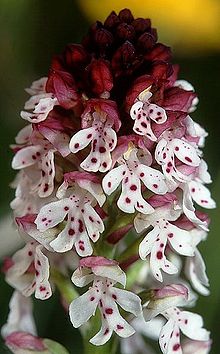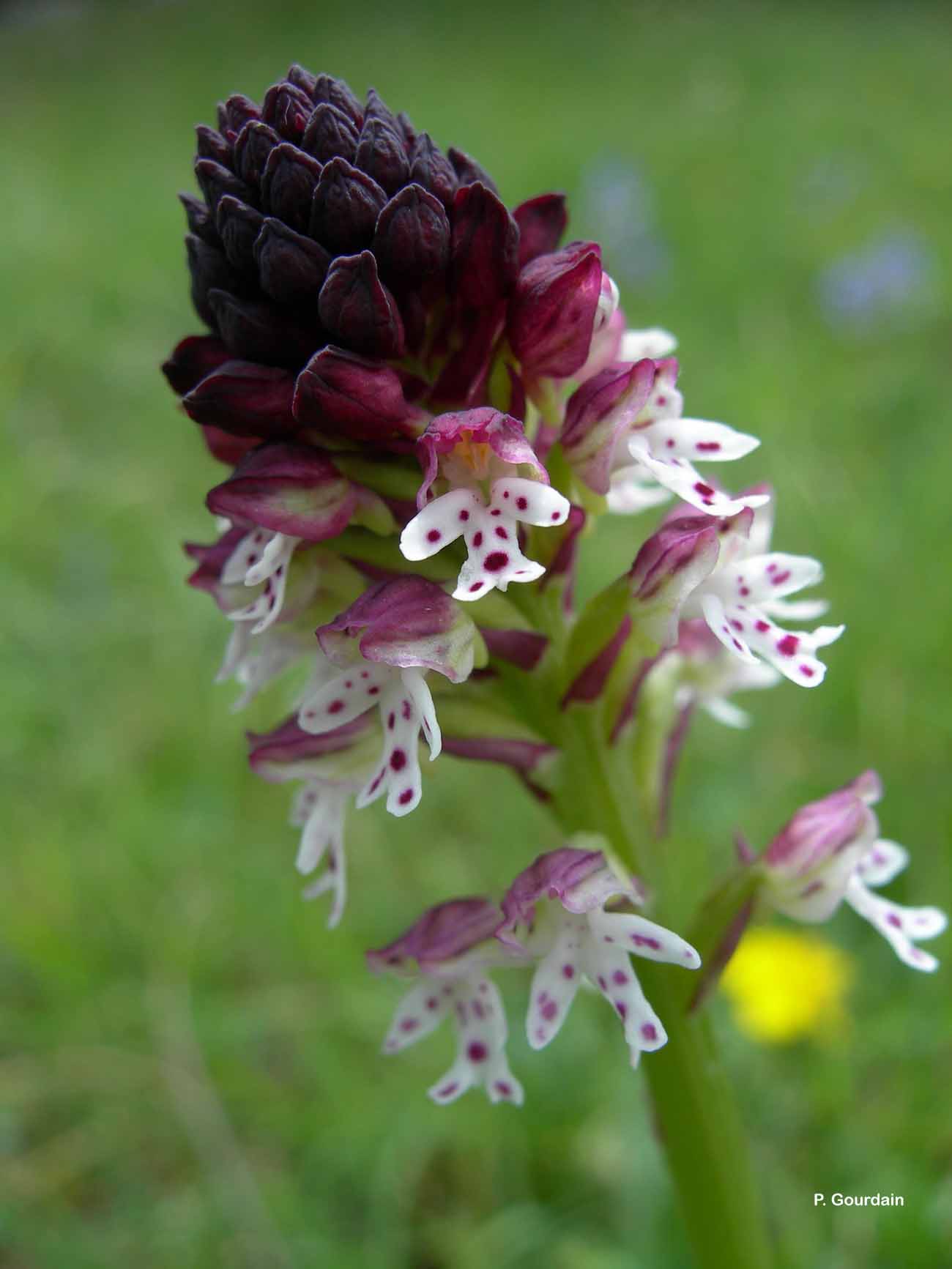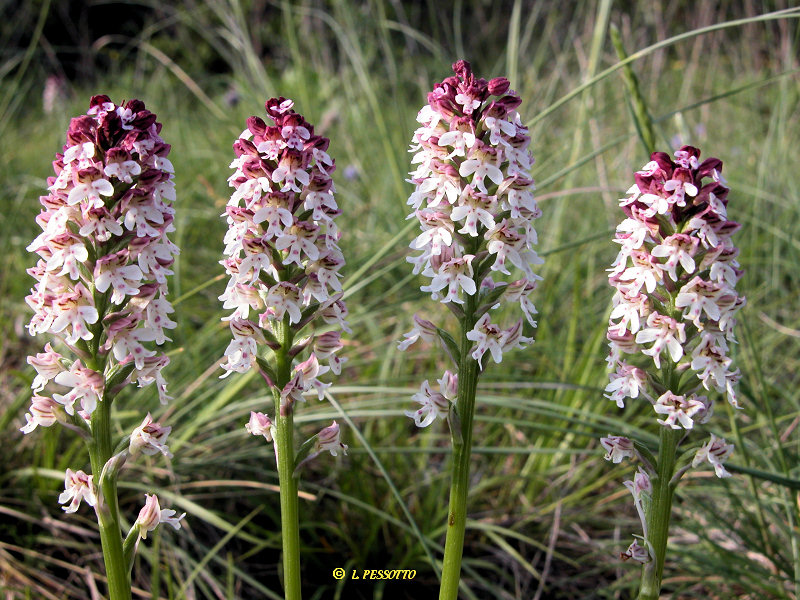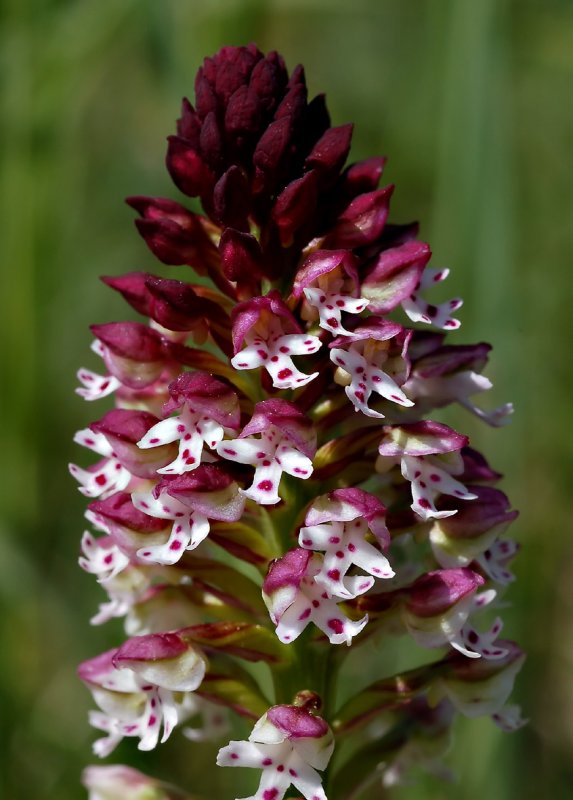Neotinea ustulata
Burnt Orchid (Orchis ustulata )
The Burnt Orchid (Orchis ustulata ) is a flowering plant in the orchid family ( Orchidaceae). It is one of the smallest species of the genus Orchis. The species is kalkliebend and settled mostly light-and heat -exposed meadows of the middle and high mountains. The Burnt Orchid applicable in Germany as endangered.
- 5.1 Germany
- 5.2 Austria
- 5.3 Switzerland
- 6.1 Red Lists
- 6.2 orchid of the year
- 8.1 Literature
- 8.2 Notes and references
- 8.3 External links
Name
The Burnt Orchid was described in 1753 by Carolus Linnaeus as Orchis ustulata. The name derives from the Greek orchis όρχις = testicles and ustulata, from Latin ustulatus = burnt, fire - starting. Accordingly, is the German name Burnt Orchid, Orchis fire or In Branded orchid. He refers to the black color of the blooming inflorescence.
Description
The Burnt Orchid is a delicate, deciduous, perennial, herbaceous growing Knollengeophyt with two small, spherical to ovoid tubers as Überdauerungsorgan. These are provided with numerous, sprouting forming secondary roots, so the plant tends to clump formation. The slim, round stalk reaches stature heights of 10 to 50 centimeters and can be a maximum of 80 inches high.
The five to ten leaves are bluish green, unspotted and lanceolate. They are about 3 to 10 inches long, about 0.5 to 2 inches wide and are used for inflorescence smaller towards. The leaves cover the stems scheidig and rosettes at the base.
The inflorescence is floriferous with many very small flowers in a cylindrical spike that extends over the flower. The bracts are only slightly shorter than the ovary. The petals ( petals ) and sepals ( sepals ) form a 3 to 4 millimeters wide, almost spherical helmet, which is externally colored dark purple to black. The lip ( labellum ) is about 5-8 millimeters in size, deep -lobed and white to pink dotted ( rarely white ). The spur is about 1 to 2 millimeters long, downward and about half as long as the ovary.
The seed of this orchid contains no nutritive tissue for the seedling. Therefore Germination occurs only when infected by a root fungus ( mycorrhiza ). The period from germination to the development of flowerable plant has not yet been adequately defined.
The Burnt Orchid is diploid with a chromosome number of 2n = 42
System
The Burnt Orchid occurs in two varieties, which differ mainly in terms of flowering time, but also morphologically:
- Orchis ustulata var ustulata characterized by rather low and compact habit and crowded at the top rounded ears from. The variety blooms mainly in May or June, and occasionally in April.
- Orchis ustulata aestivalis var Kümpel ( Syn: Neotinea ustulata aestivalis var ( dishing ) Tali, MFFay & RMBateman ) displays rather high and stretched stature and lockerblütige, pointed ears. It blooms later than the nominate form, in July or August. The scientific name of variety derives from the Latin aestivalis ( summer, summer ).
There were the following hybrids scientifically described:
- Orchis × doellii Zimmerm. (Orchis Orchis Simia × ustulata )
- Orchis × dietrichiana Bogenh. (Orchis tridentata × Orchis ustulata )
- × Anacamptorchis fallax EC Camus ( Anacamptis pyramidalis Orchis × ustulata )
- × Orchidactyla labbei C. Bernard ( Dactylorhiza maculata × Orchis ustulata )
Except for Orchis × dietrichiana the other hybrids are considered by the genetically far apart relationship of the output species as doubtful. As " var alba " white bodies are described taxonomically meaningless.
A revision of the orchid species on the basis of genetic features, the Burnt Orchid was together with some other species in the hitherto monotypic genus Keuschorchis ( Neotinea ) as Neotinea ustulata (L.) RM Bateman, Pridgeon & M. W. Chase filed. This name is now partially been used as a valid new name, however, has not been fully enforced and is not without controversy even among experts.
In addition to the valid name Orchis L. ustulata, the basionym, there are numerous synonyms, which are caused by new taxa:
- Orchis amoena Crantz
- Orchis columnae F.W.Schmidt
- Orchis parviflora Willd.
- Orchis imbricata Vest
- Orchis ustulata var leopoliensis Zapal.
- Orchis ustulata f leopoliensis ( Zapal. ) Pauca
Ecology
Heyday
Due to the considerable ecological and geographical variance, the heyday of its kind in Central Europe extending generally from April to August. This Orchis ustulata is var ustulata early flowering, late flowering Orchis ustulata aestivalis var. The single plant blooms for about three weeks. At locations in mild areas the flowering of Orchis ustulata var ustulata can begin already in the last third of April; in the Alps, however, it blooms often only in June. Since Orchis ustulata aestivalis var obviously rather occurs in middle layers, it blooms somewhat uniform from July to August.
Pollinators
As pollinators of Orchis ustulata var ustulata the tachinid fly ( Echinomyia magnicornis ) is called; for Orchis ustulata aestivalis var of longhorn beetle ( Leptura levida ) and various bumblebee species. The fruit set is usually relatively high.
Locations
The Burnt Orchid grows in Central Europe on dry and semi- dry grasslands, wet meadows, dry meadows and mountain meadows up to 2000 m, rare in sparse pine or hardwood forests as well as in drier areas of wet meadows.
Here, this species requires alternating wet, basic, rarely lime-free soils with a pH of 6.0 to 8.0.
The art is considered very heliophilic and usually occurs on vollbesonnten locations with lighting intensities to about 80,000 lux.
She has appeared in Central Europe occurrence of the following associations of the phytosociological system:
- Mesobromion
- Cirsio - Brachypodion
- Geranion sanguinei
- Arrhenatherion
( See breakdown: Phytosociological units according to Oberdorfer )
Dissemination
The distribution area of the fire - leaved orchid extends from northern Spain over Central Europe, the Alpine countries, southern Scandinavia, Eastern Europe to central Siberia and the Caucasus. In the Mediterranean, including North Africa, the Burnt Orchid is rare. It is classified according to its dissemination as Mediterranean, sub-Mediterranean and Atlantic and as Florenelement the meridional / montane, submeridionalen and classified temperate zone Flore.
Germany
In Germany, the Burnt Orchid is common edge of the Alps found scattered in the rest of Bavaria ( Altmuehltal Lechtalheiden, Franconian Alb, Main Valley, Spessart ). In Baden -Württemberg it occurs scattered, especially in the Upper Rhine and in the Swabian Alb. Rare it is in Rhineland -Palatinate and Saarland ( Mosel region - Eifel ). Further north you rarely until it hits very rare, in the extreme southwest of North Rhine -Westphalia, Hesse, Thuringia and nurmehr isolated in Saxony -Anhalt and Saxony. In Brandenburg and now apparently also in southern Lower Saxony, the species is extinct; from the other countries are no known occurrences.
Austria
In Austria, the species is scattered in all federal states, with a focus in the alpine limestone areas.
Switzerland
In Switzerland it is found almost throughout the territory. However, the Fund points are piling up in the Jura Mountains, in central Switzerland, the Rhine Valley and in the Southern Alps, on the other hand it is in the Central Plateau has become very rare.
Nature protection and hazard
Like all orchid species occurring in Europe is also the burnt orchid under the strict protection of European and national laws.
Red Lists
- Red List of Germany: 2
- Red List states: Baden- Württemberg: 2, Bavaria: 3, Berlin: - Brandenburg: 0, Bremen: 0, Hamburg: -, Hesse: 2, Mecklenburg- Vorpommern: -, Lower Saxony: 0, North Rhine -Westphalia: 3, Rhineland -Palatinate: 1, Saarland: 2, Saxony- Anhalt: 1, Saxony: 1, Schleswig -Holstein: - Thuringia: 2
- Red List of Switzerland: NT ( Near Threatened - potentially at risk )
- Red List Austria: no information available.
Sensitive to the nature reacts to changes in habitat and disappears faster than, for example, the green-winged orchid, with which it is often associated.
Orchid of the Year
The work circles Home made orchids ( AHO) in Germany, who have made in all provinces the protection, care, measures of habitats, mapping and scientific supervision of the local orchid flora mission, chose the Burnt Orchid for "Orchid of the Year" in 2005. With the choice should be made aware of the strong threat to these species of orchid that threatens to disappear from the central European landscape. The causes of decline are a part of the land use by building, the intense marsh management, fertilization and frequent mowing, on the other hand but also the utter abandonment of cultivation and thus falling into disuse of growth places.
Gallery
Orchis ustulata inflorescences
Orchis ustulata rosette of leaves
Orchis ustulata Orjen - Montenegro

.jpg)
.jpg)
.jpg)



.jpg)


